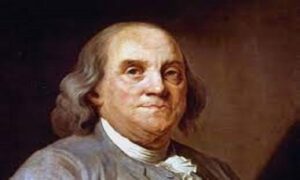Doctor Curmudgeon® Did He or Didn’t He?
By Diane Batshaw Eisman, M.D. FAAP Doctor Eisman is in Family Practice in Aventura, Florida with her partner, Dr. Eugene Eisman, an internist/cardiologist
Oceanographer.
Newspaper editor and publisher.
Diplomat.
Writer.
Postmaster General.
Scientist.
Inventor.
Political philosopher.
And one of our Founding Fathers.
Who else could this be, but Ben Franklin?
On the Feline side of our family, I am delighted to have two very active and bright nieces. I noticed one of their books lying around (as usual, tossed carelessly onto the kitchen table, absorbing their leftovers.as the kittens had decided to make their own breakfast.)
The cover had a drawing of Franklin holding onto a kite. I recall that in my childhood, I held the misconception that this incredible man had discovered electricity.
Ben Franklin’s intention was to demonstrate the connection between electricity and lightning.
Scientists had been studying electricity for years before the story of Franklin’s “famous” experiment with a kite, a key, a silk thread and a thunderstorm began to circulate.
Franklin did not record his supposed experiment with the kite. It was fifteen years later when somebody else did that.
On the History Channel, Becky Little wrote that, “Franklin wrote to his friend Peter Collinson…that an ‘Experiment has succeeded in Philadelphia’ using a kite and key, and detailed how one could go about reproducing the experiment. He didn’t specify when the experiment took place or whether he had actually conducted it.
Fifteen years later, Priestley provided some more details, writing that 46-year–old Franklin and his 22 –year-old son William had conducted the experiment sometime in June 1752.”
(EDITOR’S NOTE from Galahad, the Siberian Husky who edits Doctor Curmudgeon’s columns: Joseph Priestley was an experimental chemist, had discovered the element oxygen and was greatly interested in electricity. Priestly and Franklin had met in person and become friends.)
Franklin postulated that he could attract electricity by attaching a metal key to a kite. He would affix a silk string to protect himself from the charge. He could then send it soaring into a thunderstorm, where he could find lots of lightning. His plans included the use of a hemp string at the bottom of the kite. When the hemp was wet, it would attract electrical charges.
But does it matter it Benjamin Franklin actually conducted the experiment or not?
He was well aware of the dangers of electricity. He would have realized that conducting such an experiment could electrocute him.
Even though the kite story is most likely apocryphal, he was the first person to hypothesize that if you sharpened an iron rod to a point, “the electrical fire would, I think, be drawn out of a cloud silently, before it could come near enough to strike.”
His work with the study of electricity led to the development of the Lightning rod.
Before his studies, buildings could be devastated by fires caused by lightning strikes.
And so, Benjamin Franklin’s kite didn’t need to actually take flight.
Dr. Curmudgeon suggests “Bitter Medicine”, Dr. Eugene Eisman’s story of his experiences–from the humorous to the intense—as a young army doctor serving in the Vietnam War.
Bitter Medicine by Eugene H. Eisman, M.D. –on Amazon
Doctor Curmudgeon® is Diane Batshaw Eisman, M.D., a physician-satirist. This column originally appeared on SERMO, the leading global social network for doctors.
SERMO www.sermo.com
Click Here to Order Boxing Interviews Of A Lifetime By “Bad” Brad Berkwitt


